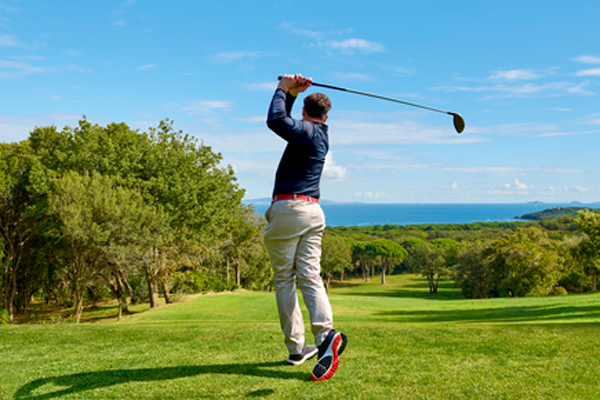1. Check Your Golf Equipment
If you haven't played in a while, it's good to give your golf equipment a once-over before heading out to the course. Check the condition of your clubs and make sure they are still the right fit for you.If you are in the market for new clubs, consider trying new equipment early in the season to get comfortable with the new setup. Many golf courses also offer the opportunity to demo clubs before you buy them.
Get Your Clubs Fitted
When shopping for new clubs, whether it be a driver, putter, or irons, you will want to get them fitted specifically for your height and swing. Getting your clubs fitted is important because using clubs that are not the right size or weight may impact your game.Most golf stores and clubs have a professional who may help you with this process, and it only takes about 30 minutes. The SPRI Golf Sports Medicine Program, co-located with The Steadman Clinic, offers golf club assessment and fitting as one of its service offerings. A club fitting considers:
- Your height
- The length of your arms
- Your swing speed
- Your handicap
Regrip Your Golf Clubs
Even if you do not need new clubs, it is good to regrip your clubs at the beginning of each season. This may help you get more control over your shots. You can usually get your clubs regripped at most golf stores, or you may even do it yourself if you are feeling handy.It is essential to choose the right grip for your clubs. There are many different kinds of grips, such as corded, ribbed, or even cross-textured. You may want to consult with a professional or do some research to determine which grips would be best for your game.
Other Equipment You May Need
The game of golf requires more than just a set of clubs. You will also need:- Golf balls
- Tees
- A golf bag
- Golf shoes
2. Warm Up Before Golfing
Before you practice at the driving range, it is important to warm up. Even though golf is a low-impact sport, you are still using muscles that might not get a lot of use during your everyday life—in fact, a golf swing engages all major joints and the spine, and rotational movement stretches muscles throughout the entire body.It is best to do light stretching before practicing your swing. Once you feel limber, you can gradually start hitting some balls. As you get closer to your tee time, you can increase the intensity of your swings. Remember that you have 18 holes to play, so don't overdo it on the range.
Golf is a mental game just as much as it is a physical one. That's why it’s a good idea to take some time to warm up your mind. One way to do this is by visualizing yourself sinking that putt or nailing that drive. Practicing breathing exercises or doing yoga might also help you clear your head and get into the zone.
3. Practice the Short Game
With your body primed and your golf equipment in good shape, it is time to practice. To ease yourself back into the swing of things, start by practicing your short game. This includes practicing your chipping, pitching, and putting.Not only is the short game a good place to start because of its lower level of intensity, but it is also an integral part of golf. Therefore, you will want to get plenty of practice before heading out onto the course. By practicing your short game, you may avoid those dreaded three-putts.
4. Hit the Driving Range
Now that you've warmed up your body and mind, it is time to start working on that perfect swing. The best way to do this is by heading to your local driving range.Start by hitting some balls with a lower loft, such as a seven or eight iron. Once you get the hang of it, you can increase the intensity and move on to hitting some drivers. Remember to focus on your form and not on how far you can hit the ball. If you can master a good swing, the distance will come naturally.
5. Set Goals for Golf Season
Before you tee off on your first round of the season, setting some goals is a good idea. This may help you stay focused and motivated throughout the season.Your goals may be anything from improving your handicap to perfecting your swing. No matter your goals, make sure they are realistic and achievable. With a little hard work and dedication, you may be surprised at how much progress you can make.
Above Par Treatment at The Steadman Clinic
While following this guide and adequately preparing for golf season may help you avoid injuries, sometimes accidents happen. The Steadman Clinic is a world-renowned orthopedic clinic devoted to treating the athlete in all of us.Whether you are suffering from golfer's elbow or a more severe injury, our team of experts may help you get back on your feet and out on the course in no time. Contact us today to schedule an appointment.
The Steadman Clinic’s research partner, Steadman Philippon Research Institute (SPRI), recently launched a golf sports medicine program that provides lessons, biomechanical assessments, club analysis and opportunities to participate in golf-specific research. The program offers services for patients recovering from injuries, analysis for professional tour players and baseline measurements for recreational golfers looking to stay at the top of their golf game, amongst other experiences. Learn more here.


